Report from 2009 IPNC
Opening Ceremonies
David Millman of Domaine Drouhin Oregon, the current President of the IPNC, introduced Dr. Thomas L. Hallie,
the President of Linfield College. Linfield is one of the oldest colleges in the western United States, dating to
1849 when Baptists established the institution before Oregon was granted statehood. The small and pastoral
campus is a perfect site for this event. Many attendees stay on campus in student dormitories and apartments.
Hallie is a Pinot Noir lover and can be seen throughout the event mixing with attendees and sharing in the
revelry. Jancis Robinson, world-renown wine educator, was attending her third IPNC, having given the keynote
speech for the first time in 1988. As the Master of Ceremonies, her preview of the event and the status of Pinot
Noir in Oregon was well-received. Each of the 65 featured Pinot Noir producers paraded to the podium and
introduced themselves. Listen to the Opening Ceremonies: “Opening Ceremonies of IPNC featuring Dr. Thomas L. Hallie and Jancis Robinson” 
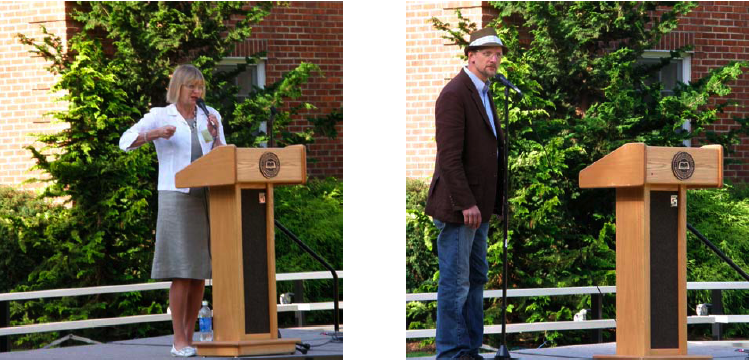
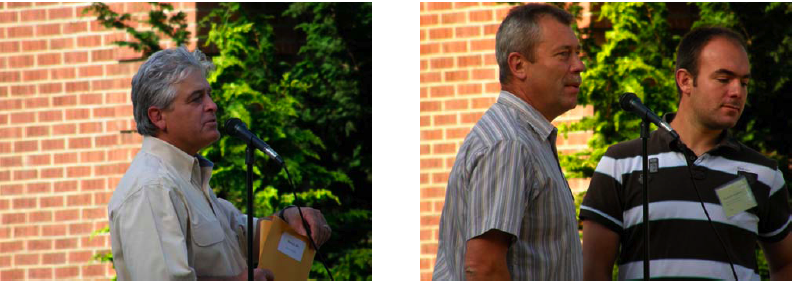

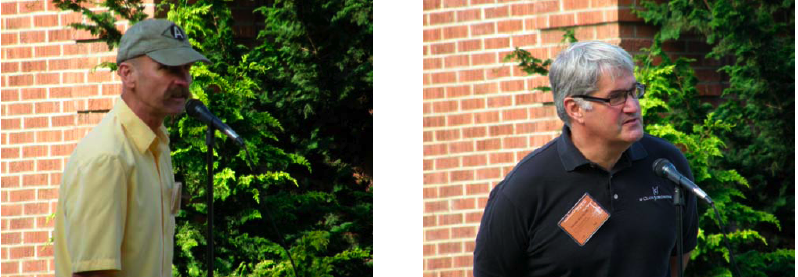
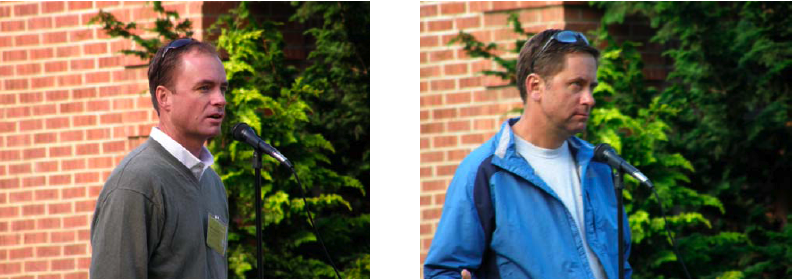
Key to photos above, top to bottom, left to right: Jancis Robinson, Jason Lett (The Eyrie Vineyards), Ken Wright (Ken Wright Cellars),
Bertrand and Francois Ambroise (Maison Ambroise), Joe Davis (Arcadian), Jeff Fink (Tantara), Rollin Soles (Argyle Winery), Thomas
Bachelder (Le Clos Jordanne), Erich Hammacher (Hammacher Wines), and Ehren Jordan (Failla).
There were approximately 700 registered attendees for the 2009 weekend, including 130 representatives from
the 65 featured wineries. The wineries hailed from Austria, Australia, California, Canada, France, New
Zealand, Oregon and Washington. There were ten Burgundy producers represented.
Australia: Kooyong Vineyard & Winery (Victoria)
Austria: Weingut Gernot & Heike Heinrich, Schloss Gobelsburg
Canada: Le Clos Jordanne (Ontario
France - Burgundy: Maison Ambroise, Domaine Charles Audoin, Domaine Fougeray de Beauclair, Domaine
Fourrier, Domaine Philippe et Vincent Lechenaut, Domaine Sylvain Pataille, Earl Domaine Pavelot,
Domaine Michele et Patrice Rion, Domaine Marc Roy, Domaine Anne et Herve Sigaut. Champagne:
Champagne Inflorescence and Champagne Roses de Jeanne. Alsace: Rene Mure, Clos St. Landelin
New Zealand: Mt. Difficulty, Pyramid Valley Vineyards, Rippon Vineyard & Winery
California: Alma Rosa Winery & Vineyards, Arcadian Winery, Buena Vista Carneros, Carmel Road Winery,
Copain Wine Cellars, Demetria Estate, Elke Vineyards, Failla Wines, Goldeneye Winery, Hanzell
Vineyards, Kosta Browne Winery, LIOCO, MacMurray Ranch Vineyards, Porter Creek Vineyards,
Tantara Winery
Oregon: Adea Wine Company, Amity Vineyards, Antica Terra, Archery Summit, Argyle Winery, Ayres Vineyard
& Winery, Belle Pente, Bergstrom Wines, Bethel Heights Vineyard, Brick House Wine Co., Duck Pond
Cellars, The Eyrie Vineyards, Hamacher Wines, Johan Vineyards, Sineann, Solena Cellars, Soter
Vineyards, Spindrift Cellars, Torii Mor, Willakenzie Estate, Youngberg Hill Vineyards, Z’IVO Wines
Washington: Benson Vineyards Estate Winery.
Meals
The meals at the IPNC share the limelight with the wines. 52 guest chefs create the meals served throughout
the Celebration along with 40 other professional and amateur chefs who volunteer their time for the IPNC. The
lunches and dinners at Linfield College are alfresco affairs. Sample menus are shown below.
The much-loved Northwest Salmon Bake is held in an oak grove on the Linfield College campus. Now in its
22nd year, it is a tradition at the IPNC. Wild salmon is cooked native Northwest style on wood stakes over a
60’ x 15’ custom-built fire pit fueled by fir and alder woods. Many volunteers from the Depoe Bay Chamber of
Commerce brave the heat and provide the succulent salmon each year for the attendees. Wine flows like
water at the dinner. Below you can see me reveling with a bottle of Sine Qua Non Hollerin’ M Shea Vineyard
Pinot Noir, one of my favorite all-time Pinot Noirs, brought to share by my good friends, Andy and Sue
Steinman.
Vineyard Tours
Guests are divided into two groups with half of the guests boarding buses and fanning out over the Willamette
Valley to various vineyard designations. The other half stay on campus for seminars. The groups switch the
following day. The winery of designation is a secret until your bus leaves the campus. Once at the winery,
guided walks of the vineyards were followed by talks about the soils and geologic history of the area, as well as
distinct characteristics of the host vineyard in keeping with this year’s IPNC emphasis on terroir. The
Oregonians are soil freaks and never to seem to tire from endlessly talking about the “mother” earth their vines
are planted in.
I traveled to De Ponte Cellars on Archery Summit Road in the Dundee Hills. De Ponte Cellars is owned and
operated by the Baldwin Family who bought the vineyard in 1999. The name De Ponte, honors the owner’s
Portuguese maternal grandfather, Manuel De Ponte. The vineyard is planted to 14 acres of several clones of
Pinot Noir and just over 3 acres of head-pruned Melon de Bourgogne (Muscadet), planted back in 1975. The
Melon planting is believed to be the oldest in Oregon.
Although Oregon has staked its claim on Pinot Noir, white varieties have achieved
considerable success of late. Pinot Gris has been the most widely planted white grape
and is Oregon's signature white wine, but I have also tasted superb examples of
Oregon Riesling, Chardonnay, Pinot Blanc, Melon, Rousanne and Pinot Noir Blanc.
Oregon Pinot Gris is usually unoaked and is often more full-bodied and flavorful than
California versions (think Alsace Pinot Gris versus Italian Pinot Grigios). In 2000, Pinot
Gris overtook Chardonnay as the most widely planted white variety in Oregon. See my
recent report on Oregon Pinot Gris.
A group of Chardonnay producers believe that world-class Chardonnay can be
produced in Oregon with the use of the proper Dijon clones. Early on, Oregon planted
Chardonnay clones such as UCD 108 and UCD 2A (Wente) that were more suited to
California's warm climate. Wide spacing of the vines and the use of rootstock that
restricted growth led to slow ripening of grapes. Now vines are planted with rootstocks
that limit vigor and are tighter-spaced. Seven notable Willamette Valley wineries have formed
the Oregon Chardonnay Alliance (ORCA) to promote the “rebirth” of Oregon
Chardonnay (www.oregonchardonnay.org). The wineries include Adelsheim Vineyard,
Argyle Winery, Chehalem, Domaine Drouhin, Domaine Serene, Hamacher Wines and
Ponzi Vineyards.

I am particular partial to Pinot Blanc, a genetic mutation of Pinot Noir, which is often
vinified like Chardonnay using oak barrel malolactic fermentation. The wine's high
acidity and appealing apple and nutty flavors make for an interesting alternative to
Chardonnay. I have had excellent examples from Ken Wright, The Four Graces and
Anne Amie.
Pinot Noir Blanc has become more than a curiosity. Pinot Noir purposely vinified in a
white wine style has aroused serious interest as an alternative white wine. Excellent
examples are produced by Anne Amie and Domaine Serene.
Almost all the great Willamette Valley Pinot Noir vineyards are situated on rocky hillsides that face south or
southeast, between 200 and 800 feet above sea level. The photo below is taken at the De Ponte Vineyard
and shows the De Ponte viticulturist in the forefront with the view from the site in the distance looking
southeast. The soils at De Ponte Vineyard are Jory type and red in color, lending the name “Red Hills of
Dundee” to the area (also visible in the photo). The red color is derived from oxidized iron in the soil. Jory
soils are basaltic or volcanic in type originating from ancient lava flows from eastern Washington and Oregon.
These soils are also found in the Chehalem Mountains and Eola-Amity Hills AVAs. According to Andy
Gallagher (www.redhillssoils.com), “The underlying soil is red clay, with upwards of 60 percent clay. A specific
feature of Jory is that despite the high clay content, the combination of mineralogy, organic matter and strong
structure causes the soils to behave like soils with less clay. The soils have a potential to yield moderately
high to high vine vigor and have ample water holding capacity for dry land viticulture.”
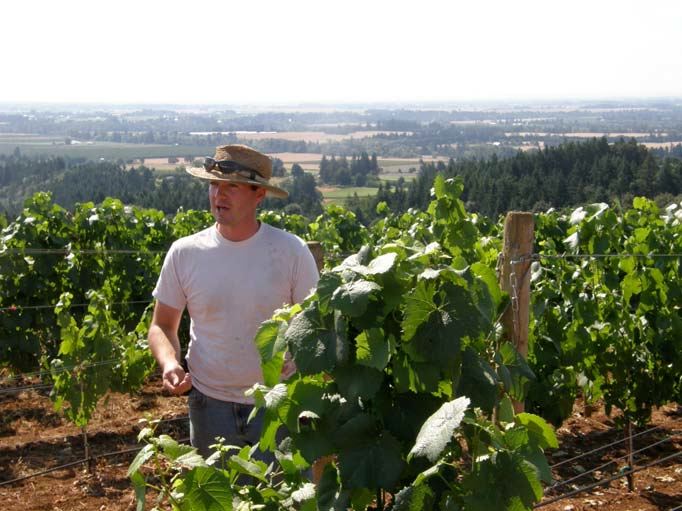
The first and only winemaker at De Ponte Cellars since 2001 is Isabelle Dutartre who has over 25 years of
experience in making wine in both France and the Dundee Hills. She assisted Veronique Drouhin at
neighboring Domaine Drouhin for five vintages, and after traveling back and forth between Oregon and France
for a number of years, is now permanently rooted in Oregon.
The De Ponte style features wines of elegance and refinement. Current releases include the 2008 De Ponte
Cellars D.F.B. Estate Melon (bright and fresh with notes of apples, pears and vanilla, $24), 2007 De Ponte
Cellars Dundee Hills Pinot Noir (20% new French oak, fabulous wine featuring red fruits, spice, bright acidity
and gossamer tannins, 1,700 cases, $38), 2006 De Ponte Cellars Dundee Hills Pinot Noir (a beautiful wine that
is delicate for the 2006 vintage with charming red stone fruit and berry flavors, supported by supple tannins and
ample acidity, 2,400 cases, $38), and the 2007 De Ponte Cellars Dundee Hills Estate Pinot Noir (primarily for
wine club members, higher percentage of new oak, sourced from selected blocks, more intensity and nuances
with a persistent finish, 196 cases, $55). Magnums of all the wines are available.
The comfortable tasting room at De Ponte Cellars is open daily from 11:00 AM to 5:00 PM at 17545 Archery
Summit Road in Dayton. Combine a visit with neighboring Domaine Drouhin, Archery Summit and White Rose
Vineyard & Winery, all of which have tasting rooms nearby that are open daily.
Seminars
Down to Earth: Digging Deeper into Oregon’s Soils
Each of five winemakers crafted a Pinot Noir from five specifically chosen vineyards in the Willamette Valley to
explore the difference between the influence of the land (terroir) versus the hand (winemaker). The five are Ken
Wright (Ken Wright Cellars and Tyrus Evan), Laurent Montalieu (formerly a partner and winemaker at
Willakenzie Estate, now owner of Soléna Cellars with his wife Danielle Andrus Montalieu and serves as the
winemaker, cofounder, and managing member of the NW Wine Company and Grand Cru Estates), Lynn
Penner-Ash (formerly President of Rex Hill Vineyards, winemaker and owner of Penner-Ash Wine Cellars since
1998), Steve Doerner (winemaker at Cristom Vineyards), and Terry Casteel (winemaker, partner and cofounder
of Bethel Heights Vineyard). The group formalized their friendship thirteen years ago after a trip to Burgundy
and called themselves “Cellar Crawl.” They spend considerable time together in each other’s cellars, travel
together to other wine regions, and conduct challenging viticulture and winemaking experiments.
The “5-5-5” project involved the above five winemakers, five vineyards (Abbott Claim Vineyard in Yamhill-
Carlton AVA, Eileen Vineyard in Eola-Amity Hills AVA, Willakia Vineyard in Eola-Amity Hills AVA, Bethel Heights
Southeast Block Vineyard in Eola-Amity Hills AVA, and Leah’s Vineyard in the Chehalem Mountains AVA) and 5
lots of 2006 Pinot Noir from each vineyard. Vineyards were chosen for uniformity so each winemaker received
essentially the same 1.25 tons of grapes. The grapes were picked from each vineyard on the same day for
each winemaker. Vinification was individualized by each winemaker.
Wines from two vineyards were offered blind to the seminar attendees. The seminar I attended had wines from
Willakia Vineyard and Southeast Block Vineyard of Bethel Heights. For me, each of the five wines made from
a single vineyard were quite different and although I could pick up some commonality to the fruit profile and
tannin structure of the vineyard, the hand seem to be more evident than the terroir. One attendee correctly
identified all five winemakers, although I did not see anyone who picked out both vineyards (I correctly
identified the Southeast Block flight).
Cellar Crawl is offering a set of 5 boxes, 5 bottles per box of the 2006 Pinot Noir made for this experiment.
Each box contains five winemakers’ versions of a single vineyard. 20% of the cost, $1,250, will be donated to
the Parkinson Center of Oregon in honor of Terry Casteel who is battling Parkinson’s Disease. Contact any of
the five wineries to order your set. (Note: Terry Casteel’s son, Ben, who is now co-winemaker at Bethel
Heights, made the wines for Bethel Heights, and Ted Casteel was the speaker representing Bethel Heights at
the Seminar.)
Each of the five winemakers spoke at the Seminar about the spirit of collaboration that has pervaded the
Oregon wine industry from the beginning. In speaking casually with several California winemakers attending
IPNC, they seemed envious of the degree of cooperation among Oregon wineries. Steve Doerner outlined the
significant events in Oregon’s young wine history that were the result of this collaboration:
•1972: Land Use Laws. These laws were intended to preserve agricultural land. Bethel Heights, which
was founded in 1977, is on land that was destined to be a trailer park.
•1977: Labeling Regulations. Oregon has the most restrictive labeling laws in the country. For
example, when a grape variety name is on a bottle, the bottle must contain 90% of that variety
The national law is 75%. European wine names such as Chablis are not allowed.
•1979: Steamboat Conference. Now an international event attended only by winemakers who critique
each others’ wines.
•1979: Wine Advocacy Board. Oregon has the highest taxes for wineries devoted to marketing and
research.
•1987: International Pinot Noir Celebration. The oldest Pinot Noir festival of its kind.
•1992: ¡Salud! Barrel Auction. Benefits the health care of Oregon’s vineyard and winery workers.
•2000: Pinot Camp. 50 wineries host 270 industry trade people from all over the country to educate
them about Oregon Pinot Noir.
•Sub-AVAs of the Willamette Valley. Still controversial, but based on consensus and cooperation. The
six sub-AVAs are largely based on the parent soil.
Dundee Hills AVA: mostly basaltic, but marine sedimentary at the lower elevations on the
western and northern slopes
Eola-Amity Hills AVA: mostly basaltic, but marine sedimentary at the lower elevations on
the western and northern slopes
Chehalem Mountains AVA: basaltic and marine sedimentary on the southern and
western slopes; ice-age loess on the northeastern slope
Yamhill-Carlton District AVA: marine sedimentary predominant
Ribbon Ridge AVA: marine sedimentary
McMinnville AVA: primarily marine sedimentary with some basalt and alluvium
Why so much emphasis on the parent soil? The flavor of Pinot Noir is dependent on the mother
rock in which it is grown. Basically, the soils of the Willamette Valley are marine
sediments with basalt or volcanic mantle in the Dundee Hills, Chehalem Mountains and
Eola-Amity Hills. The volcanic material did not arise in these areas but is the result of
lava flows from the Blue Mountains of Eastern Washington.
Laurent Montalieu spoke about the advances in viticulture which have contributed to the success of Oregon
wine:
•Trellising. Vertical shoot position trellis (VSP) allows the vines to be trained upright which facilitates the
control of vigor. The vines are hedged causing the vine’s hormones to signal the vine to stop
growing and ripen the fruit.
•Tighter spacing. In 1987 the norm was 10’ x 5’ or 10’ x 6’. Today, the spacing is significantly tighter
with ranges of 4’ x 4’ to 1’ x 1’ (1,200 to 2,000 plants per acre).
•Crop levels. Yields determine quality of the wine. Crops are thinned traditionally at veraison.
Experiments conducted in Oregon over the past four years have shown that crop thinning can
be performed shortly after set is completed. Earlier seems better. Lowering crop levels in
Oregon is crucial to cut time off the end of the growing season and avoid the rains.
•Contracts by acre. Winemakers now contract for their fruit by the acre, not by the ton. This allows
them to control yields and the resultant quality.
•Equipment. Newer equipment provides for gentle handling. Nearly all wineries now have sorting
tables. Gravity flow techniques are the norm, either through structural means or forklifts.
•Several other factors are evident but were not touched on by Montalieu: matching clones to rootstocks,
proper canopy management to expose the grapes gently to the sun, and discovery of the most
optimum vineyard sites.
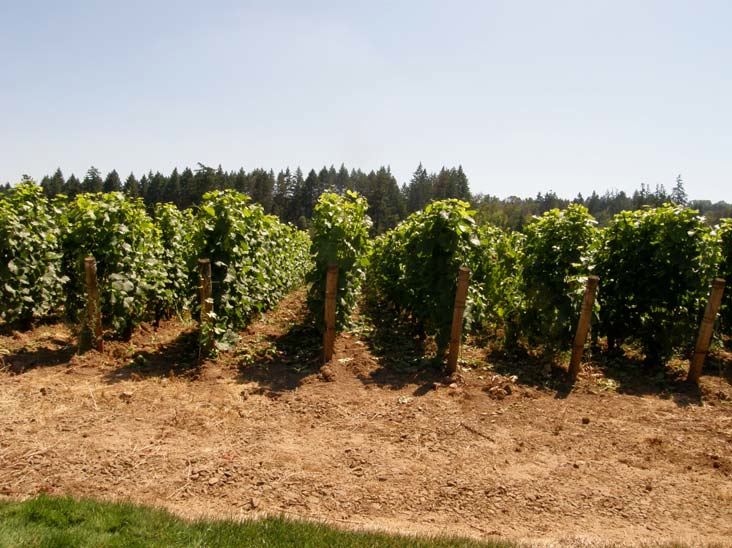
Listen to this seminar:
“Digging Deep Into Oregon Soils featuring Ken Wright, Laurent Montalieu, Lynn Penner-Ash, Steve Doerner and Ted Castell” 
Tour de Chambolle-Musigny
Journalist and Burgundy reviewer for the Wine Advocate, David Schildknecht, joined Francois Millet,
winemaker of Burgundy’s Domaine Comte Georges de Vogüé, for a virtual tour of the village of Chambolle-
Musigny, discussing the soils, geology and terroir. In addition there was a tasting of four 2006 red Burgundies
from Comte Georges de Vogüé (comp-d-vog-u-way). Photo below: Schildknecht (left), Millet (right).
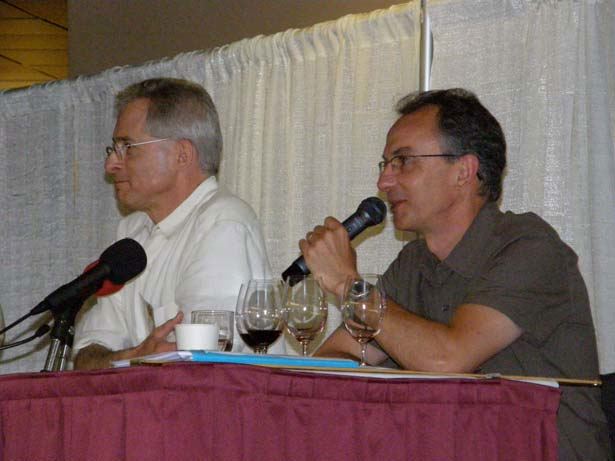
Honestly, this seminar was not as successful as the one presented at the World of Pinot Noir in 2005 in which
manager Jean-Luc Pepin and Allen Meadows presented a tasting of three vintages of Grand Cru Musigny
Vielles Vignes, Grand Cru Bonnes-Mares and 1er Cru Les Amoureuses. Meadows was able to translate for
Pepin making the seminar more understandable. Although Millet’s English is very credible, I was unsuccessful
in getting him to hold the microphone properly and he comes across very soft spoken and somewhat muddled
on the recording. In addition, I met with background noise in the recording which was not evident until after the
Seminar. I have posted the recording among my podcasts and if you listen carefully you will be able to discern
some valuable information. Without the maps and illustrations, the discourse on geology is difficult to follow.
Listen to the recording: “Tour de Chambolle-Musigny featuring David Schildknecht and Francois Millet” 
Domaine Comte Georges de Vogüé dates back to 1450 and is considered the greatest estate in Chambolle-
Musigny. The Domaine owns 6.46 hectares or 80% of the red Le Musigny Vineyard, along with 0.65 hectares
of white Musigny, 2.75 hectares of Bonnes-Mares (bone-mar), 0.56 hectares of Les Amoureuses, 0.13 hectares
of Les Boudes, 0.14 hectares of Les Fuees, and 1.81 hectares of 1er Cru Chambolle-Musigny. The winery is
run by estate manager Jean-Luc Pepin, winemaker Francois Millet and the aptly named vineyard manager Eric
Bourgogne. The estate has been owned by the same family for generations.
Chambolle-Musigny is “the” commune in Burgundy, possibly rivaled by only Vosne-Romanee and Volnay. The
unique and highly desirable wines show richness, fine tannins, a delectable balance between sweetness of fruit
and minerality, and spice, depth and delicacy. They have “power without weight,” and seem to float across the
palate. Millet spoke of a special tension or energy that the wines possess.
The Musigny and Bonnes-Mares were compared and contrasted. Each of the two vineyards have about the
same situation on the Cote hillside but the mother rock or topsoil is different. The Bonnes Mares soil is
composed of more clay, possesses slightly less drainage and the slope is less steep. The result is that the
Bonnes Mares has black fruit, blueberry and heavy rose features. It is earthy and tannic, austere and angular
when young, and often requires at least 20 years of bottle age to develop. In comparison, Le Musigny
combines the power of Bonnes Mares with the seductive elegance of Les Amoureuses. It displays redder fruit
and a more delicate rose incarnation. Despite its charm, it can age for decades.
The Domaines vineyards are farmed “as organically as possible,” meaning ho herbicides or insecticides, but if
disease pressure should arise, systemic products are employed once to control the problem. Millet stated,
“biodynamics is very courageous,” but not employed at the Domaine.
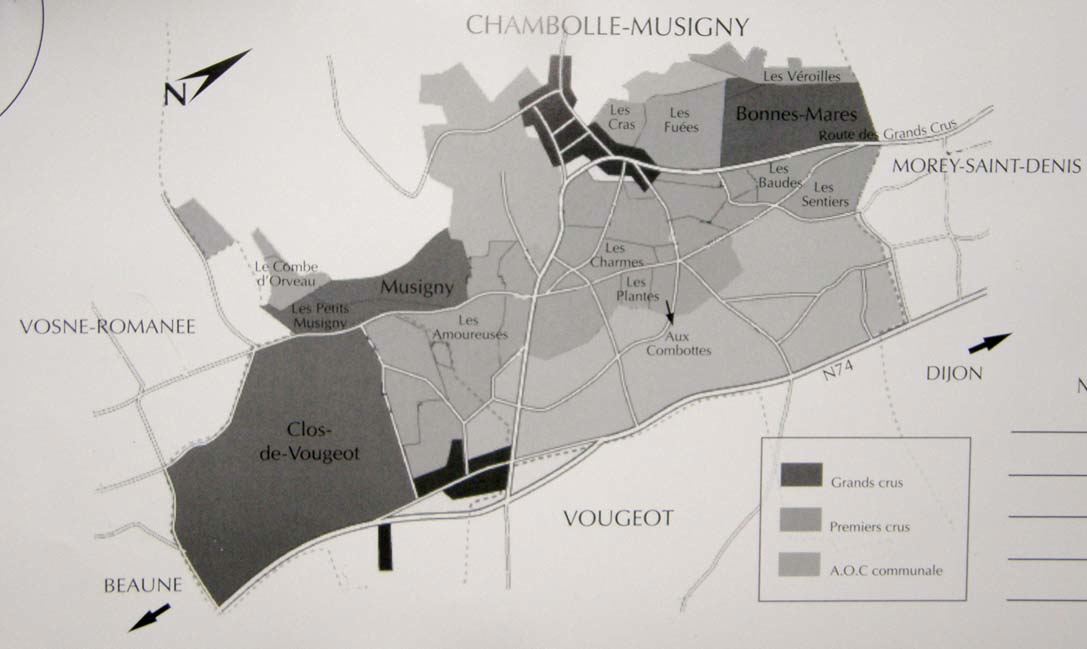
2006 Domaine Comte Georges de Vogüe 1er Cru Chambolle-Musigny
$194-$250. Sourced from the
young vines in the Le Musigny vineyard (10-25 years old). This wine is more reflective of the personality of
Chambolle-Musigny terroir than the Village wine.
·
Moderate garnet color. More fruit extract and more character
than the Village wine. Very charming spiced cherry and berry and forest floor aromas that carry over to the
flavor profile. The wine has soft but firm tannins with a lively grip of acidity on the refreshing finish. This is an
impressive wine that will stay the course for many years to come.
2006 Domaine Comte Georges de Vogüé Bonnes-Mares
$295-$450.
·
Moderately dark
garnet color. A thick wine with expressive aromas of dark red stone fruits and violets. Rich
and full-bodied on the palate with noticeable fine-grain tannins and a lingering finish that
features a return of the aromas offered on the nose. Needs time to resolve and soften the
angular and imposing structure
2006 Domaine Comte Georges de Vogüé Musigny Vielles Vignes
Vignes $380-480. From vines
that average years old (26-55 years old).
·
Moderate garnet color. Red raspberries and
cherries dominate the restrained nose. Well-endowed core of red fruits flush with minerality
and perfectly complimented by supple tannins and soft acidity. The finish is impressively
long and aromatic. Still tight and no where near what it will be in ten to twenty years.

The prices are astonishing, but this Domaine’s wines are a luxury product that satisfies a
demand. Your best option might be to befriend someone else who has the means to buy
these exemplary Burgundies.
Pinot Noirs that Impressed at Alfresco Tastings
At the IPNC, there are alfresco tastings in the late afternoon on successive days where the featured wineries
pour their wines. This is not a venue for serious wine tasting, but some impressions can be gathered. There
are certain wines that stand out and I have listed below wines that deserve your special attention.
Kooyong Vineyard & Winery 2007 Ferrous Single Vineyard The Kooyong Vineyard and Winery are located
at Tuerong on the northern end of the Mornington Peninsula, about an hour’s drive south of Melbourne,
Victoria, Australia. Kooyong was established in 1995 on a gentle undulating 250 acre property. The Kooyong
name means “where the wild fowl gather,” and is derived from the property’s location neighboring Devilbend
Reserve, the home to many native water birds. Kooyong has 75 acres of vines planted to Pinot Noir,
Chardonnay and Pinot Gris. The winemaker is Sandro Mosele who focuses on preserving the region, the
variety and the site where the grapes are grown.
Schloss Gobelsburg 2002 Alte Haide Magnum Schloss Gobelsberg is the oldest winery in the Danube area
of Kamptal with a documented viticultural history dating back to the 12th century, when Cistercian monks from
Burgundy started to work their first vineyards in the area. Gobelsburg has been run by Michael Moosbrugger
since 1996. Grüner Veltliner and Riesling are the winery’s most important varieties.
Domaine Fougeray de Beauclair 2007 Bonnes-Mares This Domaine is a regular
visitor to the IPNC and the winery’s Bonnes-Mares is unique in that it is very
approachable soon after release. Imported by Triage Wines in Oregon and
Washington (Le Serbet, Becky Wasserman Selections). Our table was treated to the
2003 version of this wine at the Friday night Grand Dinner and it was easily the wine
of the event for all of us who tasted it.
Domaine Fourrier 2007 Gevrey 1er Cru, Clos St. Jacques Previously known as Pernot-Fourrier, Domaine
Fourrier has a long history in Gevrey Chambertain extending over four generations. With 22.5 acres of
vineyards in the communes of Gevrey Chambertain, Morey-Saint-Denis and Chambolle-Musigny, this Domaine
is one of the most well-endowed estates. Vines average between 50 and 70 years of age. Jean Marie Fourrier
took the reigns in 1994 and was able to combine the traditions of his father, his experience gained while
working with Henri Jayrer and Domaine Drouhin Oregon, and his own clear sense of style. Ever since his
ascension, the wines of Domaine Fourrier have garnered critical acclaim. The trio of wines I tasted from this
Domaine at IPNC were very, very impressive. Les Champeaux and Clos St. Jacques are clearly two wines to
buy from this vintage. Imported by Neal Rosenthal.
Domaine Philippe et Vincent Lecheneaut 2007 Nuits-Saint-Georges 1er Cru Les Pruliers Fernand
Lecheneaut created this 22-acre estate in the early 1960s while working for a negociant in Beaune. He took
advantage of opportunities to buy parcels of various vineyards when they became available and eventually quit
his negociant position when he had acquired enough vineyard acreage. His sons Phillipe and Vincent took
over in 1985. All of their vines are in the Cote de Nuits, spread throughout Nuits-Saint-Georges, Morey-Saint-
Denis, Vosne-Romanee, and Chambolle-Musigny with a small parcel of the Grand Cru Clos de la Roche. The
Domaine produces 13 different bottlings yearly, totaling 6,000 cases.
Domaine Michele et Patrice Rion 2006 Nuits-Saint-Georges 1er Cru Clos Saint Marc. This Burgundian
estate was created in 1990, beginning with only 2.5 acres of vines. Today, the Rions have 22 acres from five
different communes. Until 2000, Patrice was the winemaker at Domaine Daniel Rion & Fils. The 2006 Clos
Saint Marc was the first vintage to bear the Rion name as the vineyard was only acquired in 2006.
Domaine Marc Roy 2006 Clos Saint Landelin Domaine Marc Roy has been in the family for four
generations. The estate includes 9 acres of Pinot Noir and 1 acre of Chardonnay, producing about 1,800
cases annually. Owner and winemaker, Marc Roy, inherited his love for winegrowing from his father and
grandfather. His daughter, Alexandrine, took over the job of winemaker and manages the vineyard with her
father.
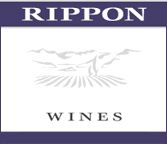
Rippon Vineyard & Winery 2006 Rippon Pinot Noir Rippon has been cared for by
the Mills family for four generations and its vines have had their roots deep within the
site’s schist-laden soils for over 25 years. Nick Mills, the son of Central Otago’s
viticulture pioneers Rolfe and Lois Mills, was born at the same time as his parents’
first plantings. Nick lived in Burgundy from 1998 to 2002, where he graduated from
the CFPPA de Beaune and worked in several of France’s most esteemed estates
including Domaine Jean-Jacques Confuron and Domaine de la Romanee-Conti. He
returned to Rippon in 2002 and has applied biodynamics to the farming of the
Rippon vineyard. He is currently the President of the Central Otago Winegrowers’
Association and has played a key role in Central Otago’s region-wide organic
initiative. Imported by Station Imports, Colorado.
Hanzell Vineyards 2006 Winemaker’s Block Sonoma Valley Pinot Noir and 2006 Sonoma Valley Pinot
Noir In 1953, Ambassador James Zellerbach founded Hanzell Vineyards on a 200-acre estate perched in the
hills high above the town of Sonoma. The original vineyard block is now the oldest producing Pinot Noir
vineyard in the New World. The winery’s vineyards are planted on the rocky and steep slopes that surround
the winery. Today, the winery produces 6,000 cases of estate-bottled Chardonnay and Pinot Noir. The focus
and hallmark of Hanzell wines is their structure and long term age ability in the tradition of Grand Cru
Burgundy. Michael McNeil is the winemaker and I was fortunate to sit with him at a pre-IPNC dinner. He is a
bright and passionate winemaker who shared the wonderful 2006 Hanzell Pinot Noir at dinner. Hanzell wines
are a California treasure and ones you must try if you are a devoted pinot aficionado.
LIOCO 2007 Michaud Vineyard Chalone Pinot Noir LIOCO is the result of years of conversation between
Matt Licklider (a wine import specialist) and Kevin O’Connor (former wine director at Spago Restaurant in
Beverly Hills) about whether California could produce a true “wine of origin.” After gathering opinions on the
subject from some of the world’s great wine producers, they arrived at the conclusion that California could
achieve a wine of origin, provided certain protocols were adhered to in the vineyard and in the cellar. Inspired
by traditional European winegrowing practices, LIOCO seeks out vineyard sites with tougher soils, older vines
and select clones. They then shepherd the grapes from bud to bottle in the least intrusive way possible. Kevin
Kelley is the talented winemaker. LIOCO’s focus is on naturally fermented Chardonnay (in stainless steel) and
Pinot Noir (in neutral or very low percentage new French oak).
Bergström Wines 2007 Bergström Vineyard Pinot Noir Bergström Wines is a family owned and operated
business located outside Newberg on the southern facing hillsides of Chehalem Mountains. Three estate
vineyards in the Chehalem Mountains and Dundee Hills total 35 acres, and are all farmed biodynamically
(Demeter certified). Bergström produces small lots of Pinot Noir (8,000 cases), Chardonnay (800 cases) and
Riesling (800 cases). Josh Bergström is the general manager, winemaker and vineyard manager.
Carabella Vineyard 2006 Inchinnan Pinot Noir Geologist and winemaker Mike
Hallock produces estate-grown wines from a hillside vineyard which represents the
culmination of a 12-year search for an appropriate location to combine the best of
Oregon and French terroir. Pinot Noir is the main emphasis, with five clonal blocks
fermented separately, then blended to show the complexity of the vineyard. Carabella
also produces a Pinot Gris and Dijon 76 clone Chardonnay.
Cristom Vineyards 2007 Eileen Vineyard Eola-Amity Hills Pinot Noir The BEST
wine I tasted from Oregon at the alfresco tastings. In 1992, Paul and Eileen Gerrie
established Cristom Vineyards and lured talented winemaker Steve Doerner from
Calera Wine Company in California and vineyard manager Mark Feltz. The estate
consists of more than 50 acres on an east-facing slope in the Eola Hills with high-density planting of Dijon
clones on specifically selected rootstocks. Cristom’s techniques include up to 50% whole clusters, native yeast
fermentations and bottling without filtration. Pinot Noir, Chardonnay, Pinot Gris and Viognier production totals
9,000 cases annually.
Dobbes Family Estate Winery 2006 Quailhurst Vineyard Chehalem Mountains Pinot Noir Joe Dobbes
began his winemaking career apprenticing with wine masters in Germany and France before applying his skills
to craft wine for several esteemed Oregon wineries including Willamette Valley Vineyards. Dobbes operates
Wine by Joe, LLC, a multitiered business that produces three brands: Dobbes Family Estate, Wine by Joe, and
Jovino Oregon Pinot Noir. Pinot Gris, Viognier and Syrah round out the portfolio.
Johan Vineyards 2006 Johan Vineyards Pinot Noir Winemaker Dan Rinke
graduated from California State University Fresno and became an assistant
winemaker at Domaine Alfred in the Central Coast of California. He moved on to
Rhys Vineyards in the Santa Cruz Mountains for a year and then became the
vineyard manager and winemaker at Johan Vineyards in 2007. This is a new and
promising producer of Oregon Pinot Noir.
Shea Wine Cellars 2007 Pommard Clone Yamhill-Carlton District Pinot NoirFounded by Dick and Deirdre
Chea in 1996, Shea Wine Cellars produces Pinot Noir and Chardonnay sourced from the famed Shea
Vineyard. Shea Vineyard was first planted in 1989 in a then untried viticulture area. The 200-acre property lies
in the Yamhill-Carlton District and supplies fruit to some of Oregon and California’s finest wineries. Current
production at Shea Wine Cellars is 5,200 cases of Pinot Noir and 400 cases of Chardonnay. The winemaker is
Drew Voit.
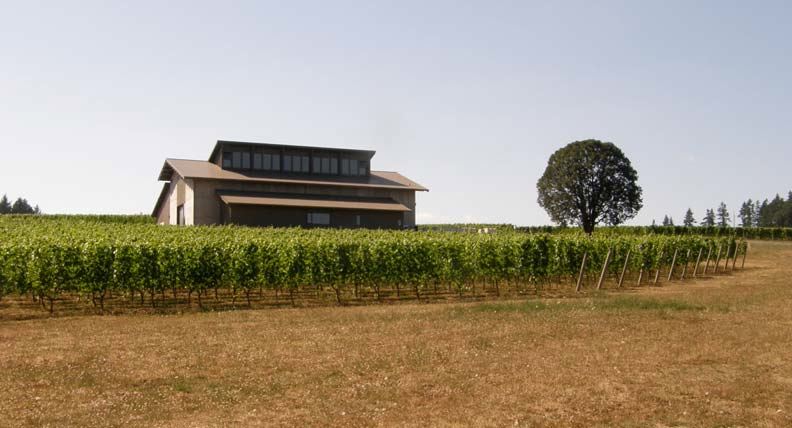
Soléna Cellars 2006 Domaine Danielle Laurent Yamhill-Carlton District Pinot Noir Laurent Montalieu and
Danielle Andrus-Montalieu came together to create a family operated winery, Soléna Cellars. Soléna is the
combination of the words ‘sun’ and moon’ in French and is the name they gave to their daughter. Soléna
Cellars was founded in Carlton in 2002. All the vineyards from which they source, including the estate
Domaine Danielle Laurent Vineyard (also known as the Wedding Vineyard because guests to the couple’s
wedding were asked to bring a vine in place of a gift and the vines were then planted in the couple’s vineyard)
and the historic 100-acre Hyland Vineyard are cropped to low yields and produce high-quality fruit. Vineyard
management techniques explore all aspects of viticulture, including biodynamics. Note Laurent’s Chihuahua
below, the smallest vineyard dog I have ever seen.